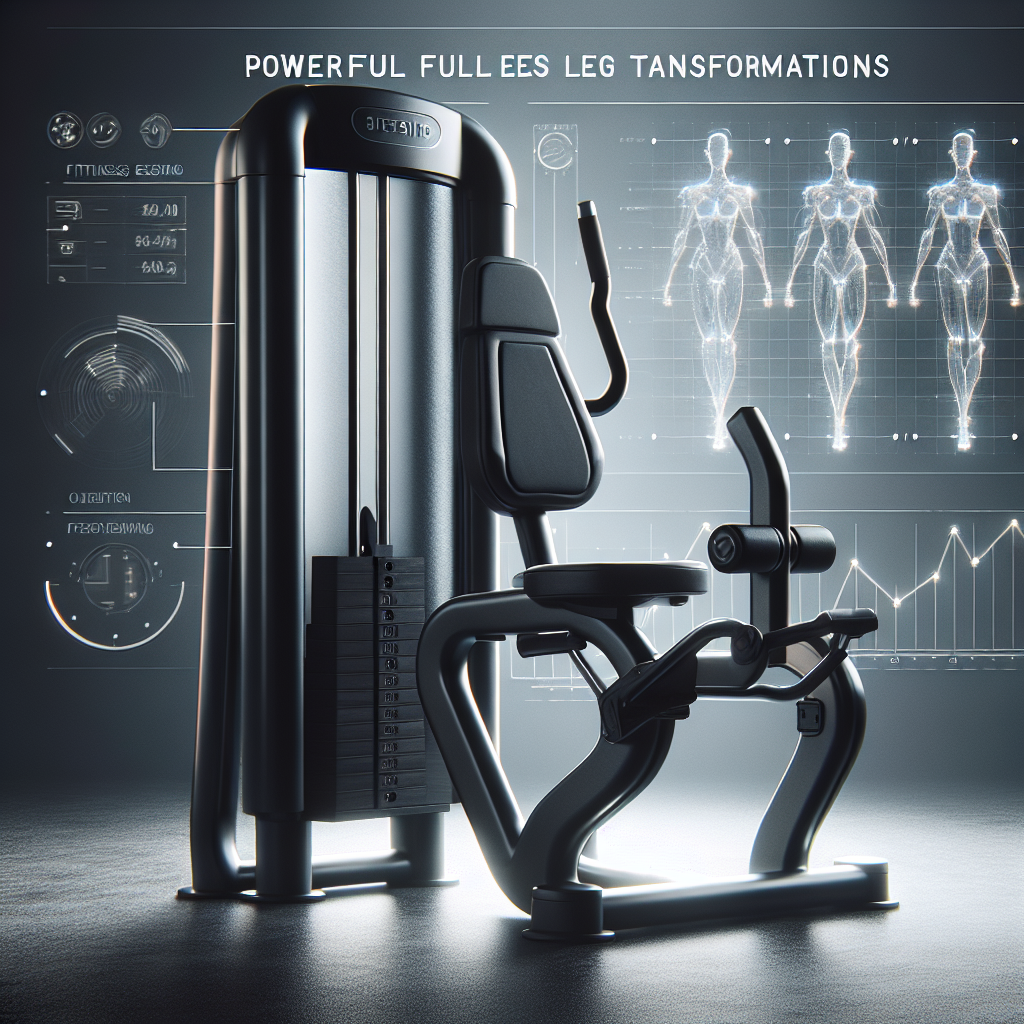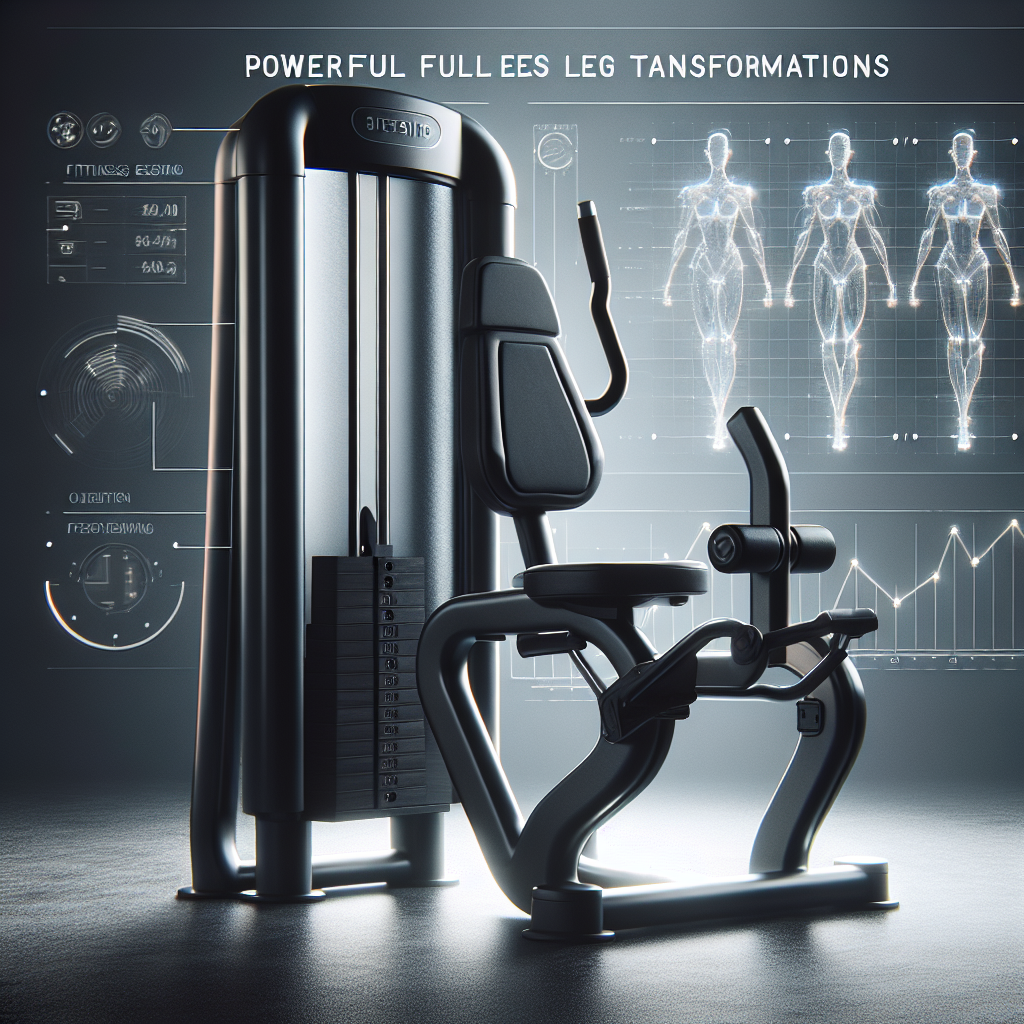In the realm of modern fitness equipment, one crucial area that often gets overlooked is leg training. The role of leg muscles in overall strength and stability cannot be underestimated, and yet, the lack of attention given to this aspect is concerning. To address this issue, a cutting-edge gym machine specifically designed for targeting leg muscles has emerged. In this article, we will explore the various features and benefits of this innovative gym machine, compare its costs with other similar products in the market, and provide a comprehensive overview of its capabilities. By the end of this article, you will have a greater understanding of why incorporating this gym machine into your workout routine is essential for achieving optimal leg strength and functionality.

Overview of Gym Machines for Legs
Introduction to leg exercise machines
Leg exercise machines are an essential part of any comprehensive workout routine. They are specifically designed to target and strengthen the muscles in our lower body, including the glutes, quadriceps, hamstrings, calves, and thighs. These machines provide a versatile and efficient way to engage these muscles, allowing us to build strength, increase endurance, improve balance, and enhance overall athletic performance. In this article, we will explore the various types of gym machines for legs, their functionalities, benefits, and tips for effective usage.
Benefits of using gym machines for legs
Using gym machines for leg exercises offers several benefits. First and foremost, they provide a safe and controlled environment for working out, reducing the risk of injury compared to free weight exercises. These machines are also designed to provide support and stability, making them suitable for individuals of all fitness levels. Furthermore, gym machines allow for isolation of specific muscle groups, allowing us to target and strengthen the legs more effectively. They also offer a wide range of resistance settings, allowing for progressive overload and customizable workouts.
Common types of gym machines for legs
There are several common types of gym machines specifically designed for leg exercises. These machines include leg press machines, squat machines, hack squat machines, lunging machines, calf raise machines, leg extension machines, hamstring curl machines, and adductor/abductor machines. Each machine serves a unique purpose and targets different muscles in the lower body. Understanding the functionalities and proper usage of these machines is crucial for maximizing our leg workouts and achieving desired results.
Leg Press Machines
How leg press machines work
Leg press machines are one of the most popular and versatile gym machines for targeting the leg muscles. They typically consist of a seat or platform that slides along a track, allowing us to push against a resistance using our legs. As we push against the resistance, our quadriceps, glutes, and hamstrings are engaged, resulting in effective leg strengthening. Leg press machines can provide both horizontal and vertical movements, depending on the machine’s design.
Different variations of leg press machines
There are various types of leg press machines available in the market. One common variation is the plate-loaded leg press machine, where weight plates are loaded onto a sled that slides along the track. Another variation is the selectorized leg press machine, which utilizes a stack of weight plates with a pin or lever system for adjustable resistance. Additionally, some leg press machines offer a seated position, while others allow for a reclined or horizontal position.
Tips for using leg press machines effectively
To make the most out of leg press machine workouts, it is essential to focus on proper form and technique. Firstly, it is crucial to adjust the seat or platform position according to our body size and comfort. The feet should be placed shoulder-width apart, ensuring that the knees are aligned with the toes during the movement. It is important to engage the core and maintain a stable lower back position throughout the exercise. Gradually increase the resistance and start with lighter weights to perfect the form before progressing to heavier loads.

Squat Machines
Functionality of squat machines
Squat machines are specifically designed to replicate the movement pattern of traditional free-weight squats. These machines utilize a guided barbell or a lever system to provide resistance and support during the squat exercise. Squat machines offer a more controlled motion, allowing us to focus on proper technique and form without the need for additional stabilization. They are an excellent option for those who struggle with balance or have limited mobility.
Types of squat machines
There are different types of squat machines available, each offering a unique approach to the exercise. One common variation is the Smith machine squat, which consists of a barbell fixed within a vertical track. This machine provides a guided path and safety catches, offering increased stability. Another type is the plate-loaded squat machine, where weight plates are loaded onto a sled that slides along a track. Additionally, some squat machines incorporate a lever mechanism that adjusts the resistance based on our movement.
Proper technique for using squat machines
When using squat machines, it is crucial to focus on maintaining proper form throughout the exercise. Start by adjusting the machine to the appropriate height, ensuring that the barbell or lever is resting comfortably on the shoulders or upper back. Place the feet slightly wider than shoulder-width apart, toes pointed slightly outward. As we lower our body down into a squat, ensure that the knees track in line with the toes and the chest remains upright. Engage the glutes and quadriceps to push through the heels and return to the starting position.
Hack Squat Machines
Overview of hack squat machines
Hack squat machines provide a variation of the traditional squat exercise by utilizing a sled or platform to push against. This machine allows for a more vertical movement pattern, putting more emphasis on the quadriceps. Hack squat machines also offer increased stability and support, making them suitable for individuals who are new to squat exercises or have limitations with a traditional barbell squat.
Benefits of using hack squat machines
Using hack squat machines offers several benefits for leg strengthening. First and foremost, they provide a safe and controlled environment for working out the quadriceps muscles. This machine also targets the glutes, hamstrings, and calves to a lesser extent, providing a well-rounded lower body workout. Hack squat machines offer the advantage of customizable resistance, allowing us to gradually increase the load as strength progresses.
Proper form and safety precautions
To perform hack squat exercises safely and effectively, it is important to follow proper form and safety precautions. Start by adjusting the machine to the appropriate height, ensuring that the shoulders are positioned comfortably underneath the shoulder pads. Place the feet hip-width apart on the platform, ensuring that the knees are aligned with the toes. With a controlled movement, lower the body by bending the knees and hips, keeping the back flat against the pad. Push through the heels and extend the knees and hips to return to the starting position.

Lunging Machines
The purpose of lunging machines
Lunging machines are specifically designed to target the muscles involved in lunging movements, such as the glutes, quadriceps, and hamstrings. These machines provide a guided path for performing lunges, reducing the risk of improper form and instability. Lunging machines offer a variety of resistance options, allowing us to adjust the load according to our fitness level and desired intensity.
Different designs of lunging machines
There are different designs of lunging machines available in fitness facilities. One common variation is the standing lunge machine, which resembles a platform with adjustable resistance and handles for stability. Another variation is the seated lunge machine, where the user is seated and performs lunges against a resistance. Additionally, some lunging machines incorporate adjustable angles and range of motion, providing versatility in targeting different muscle groups.
Tips for maximizing lunging machine workouts
To maximize the effectiveness of lunging machine workouts, it is important to maintain proper form and technique. Start by adjusting the machine to the appropriate height and selecting the desired resistance level. Stand or sit with the shoulders in line with the handles or pads, ensuring stability and balance. While lunging forward, keep the front knee aligned with the ankle and lower the body until the back knee gently touches the ground. Push through the front heel and engage the glutes and quadriceps to return to the starting position.
Calf Raise Machines
How calf raise machines target the lower legs
Calf raise machines are specifically designed to target the muscles in the lower legs, primarily the calves. These machines typically consist of a platform or foot plate that allows for controlled up and down movements of the ankles. By placing the balls of the feet on the platform and pushing downward against the resistance, the calves are engaged, resulting in strengthened lower leg muscles.
Varieties of calf raise machines
There are various types of calf raise machines available in fitness centers. One common variation is the seated calf raise machine, where the user sits and extends the legs to perform calf raises against a resistance. Another variation is the standing calf raise machine, which involves standing on a platform or foot plate and pushing upward with the calves. Additionally, some calf raise machines incorporate a lever system or weight plates for adjustable resistance.
Important considerations for effective calf raises
When using calf raise machines, it is important to consider proper form and technique. Start by adjusting the machine to the appropriate height, ensuring that the balls of the feet are fully supported on the platform. Begin with the feet hip-width apart and the ankles in a neutral position. Push the platform or foot plate downward, extending the ankles and engaging the calves. Hold the position briefly at the top before gently lowering the heels back to the starting position. Gradually increase the resistance as strength improves to achieve progressive overload.

Leg Extension Machines
Key features of leg extension machines
Leg extension machines are specifically designed to target and strengthen the quadriceps muscle group in the front of the thighs. These machines typically consist of a seat, backrest, and leg pads that allow for controlled extension movements of the knees. By sitting on the machine and extending the legs against the resistance, the quadriceps are engaged, providing an effective isolation exercise for these muscles.
Muscles worked with leg extension exercises
Leg extension exercises primarily target the quadriceps muscle group, including the rectus femoris, vastus lateralis, vastus intermedius, and vastus medialis. These muscles are responsible for extending the knee joint and play a crucial role in balancing and stabilizing the body during various movements. By strengthening the quadriceps through leg extension exercises, we can improve lower body strength, knee stability, and overall athletic performance.
Proper technique and precautions
Maintaining proper technique and taking necessary precautions is crucial when using leg extension machines. Start by adjusting the machine according to the desired settings, ensuring that the seat height and leg pads are aligned with the knees. Sit on the machine with the back flat against the backrest, and place the shins against the leg pads. Engage the core, grasp any handles for stability if available, and extend the legs fully, pushing against the resistance. Hold the extended position for a moment before gradually returning to the starting position, avoiding any jerky or abrupt movements.
Hamstring Curl Machines
Overview of hamstring curl machines
Hamstring curl machines are specifically designed to target and strengthen the muscles at the back of the thighs, primarily the hamstrings. These machines typically consist of a seat, leg pads, and a lever system that allows for controlled curling movements of the legs. By lying face down on the machine and curling the legs against the resistance, the hamstrings are engaged, providing an effective isolation exercise for these muscles.
Benefits of hamstring curl exercises
Hamstring curl exercises offer several benefits for the lower body. By targeting the hamstrings, these exercises can help improve lower body strength, enhance athletic performance, and reduce the risk of hamstring injuries. Hamstring curls also contribute to overall leg balance, functional movement, and muscular symmetry. Engaging in regular hamstring curl exercises can also enhance knee stability and joint integrity, which is essential for various physical activities.
Tips for using hamstring curl machines safely
To use hamstring curl machines safely and effectively, it is important to focus on proper form and technique. Start by adjusting the machine to the appropriate settings, ensuring that the leg pads align with the back of the ankles. Lie face down on the machine with the hips and torso in a stable position. Grasp any handles or supports for stability, engage the core, and curl the legs up towards the glutes, squeezing the hamstrings. Avoid any jerky or sudden movements and maintain control throughout the exercise. Gradually increase the resistance as strength and comfort allow.
Adductor/Abductor Machines
Functionality and purpose of adductor/abductor machines
Adductor/abductor machines are specifically designed to target the muscles of the inner and outer thighs. These machines typically consist of a seat, leg pads, and a lever system that allows for controlled adduction and abduction movements of the legs. Adductor exercises involve squeezing the legs together against resistance, targeting the inner thigh muscles. Conversely, abductor exercises involve pushing the legs outward against resistance, targeting the outer thigh muscles.
Targeting inner and outer thigh muscles
Adductor/abductor machines are effective in targeting and strengthening the inner and outer thigh muscles. The adductor exercises primarily target the muscles responsible for leg adduction, namely the adductor longus, adductor magnus, adductor brevis, and the gracilis. On the other hand, the abductor exercises primarily target the muscles responsible for leg abduction, including the gluteus medius, gluteus minimus, and tensor fasciae latae. By engaging and strengthening these muscle groups, we can enhance the stability, balance, and overall function of the lower body.
Proper body alignment and adjustments
When using adductor/abductor machines, it is important to focus on proper body alignment and adjustments. Start by adjusting the machine to the appropriate settings, ensuring that the leg pads align with the inner or outer thighs. Sit on the machine with the back against the backrest, engage the core, and align the knees with the ankles. For adduction exercises, squeeze the legs together, pushing against the resistance. For abduction exercises, push the legs outward, maintaining control and avoiding any jerky movements. Gradually increase the resistance as strength and comfort allow.
Summary and Comparison
Cost comparison of gym machines for legs
When considering the cost of gym machines for legs, factors such as brand, quality, functionality, and additional features should be taken into account. Leg press machines, squat machines, hack squat machines, and lunging machines can range in cost from $1,000 to $5,000. Calf raise machines, leg extension machines, hamstring curl machines, and adductor/abductor machines usually fall within the $500 to $2,500 price range. It is essential to consider the long-term value, durability, and warranty offered by the manufacturer to make an informed purchasing decision.
Summary of each machine’s benefits and limitations
Leg press machines offer a versatile way to target the lower body muscles, providing support and resistance for effective leg strengthening. Squat machines provide a controlled and stable environment for performing squats, allowing for proper technique and form without the need for additional stabilization. Hack squat machines target the quadriceps and offer increased stability, making them suitable for individuals with limitations or new to squat exercises.
Lunging machines provide a guided path for lunging movements, targeting the glutes, quadriceps, and hamstrings. Calf raise machines specifically target the calf muscles, offering customizable resistance and strengthening the lower legs effectively. Leg extension machines isolate the quadriceps muscles and provide a controlled environment for focused workouts. Hamstring curl machines target and strengthen the hamstrings, reducing the risk of injury and improving athletic performance.
Adductor/abductor machines target the inner and outer thigh muscles, contributing to leg muscle balance and stability. Each machine comes with its own set of benefits and limitations, and the choice depends on individual fitness goals, preferences, and budget.
In conclusion, incorporating gym machines for leg exercises into our fitness routine can offer numerous benefits. These machines provide a safe, controlled, and efficient way to target and strengthen the leg muscles, allowing for improved strength, endurance, balance, and overall athletic performance. By understanding the functionalities, proper techniques, and considerations of various gym machines for legs, we can maximize the effectiveness of our leg workouts and achieve desired results.


One thought on “Gym Machine For Legs”